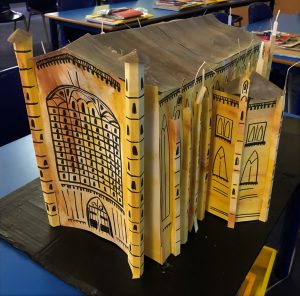If the children cannot go to Windsor, then Windsor must come to the children, Kristian Greenslade decided, to the excitement of his young pupils.
Delighted to have been admitted to the Institute of Education (IoE) at the University of Reading to study BA Primary Education, Kristian describes his feelings as ‘super-excited’. Yet soon after his course began, the young trainee teacher was plunged into a world crisis. As the Covid pandemic unfolded, even qualified, experienced teachers faced immense challenges. Everyone was learning new ways of teaching in classrooms and online while looking after the mental and physical health of themselves and their pupils.
Pre-pandemic, one of Kristian’s school’s biggest plans had been to take the Year One pupils on a trip to historic St George’s Chapel, Windsor, where Prince Harry and Meghan Markle married. Kristian’s pupils, all aged between five and six, were excited about visiting the Castle they had seen on television and in pictures. They had been learning all about its history, drama and current events. But then came the pandemic and the world shut down. The children were devastated.
Kristian had to think fast and find a way to transform his pupils’ disappointment into excitement. He talked to his wife Angelli, who is a talented hobby artist. Together, they came up with a brilliant way to show the wonder of Windsor Castle without being there in person.
They created a beautiful, metre-long model of the Chapel.

“I think for children who are five or six years old, learning about facts, dates and churches can be overwhelming. Some might just switch off. So I had the idea of giving them something visual and physical to see and be excited about, in place of their trip.”
By viewing all aspects of the Chapel online, Kristian and Angelli recreated the architecture of the chapel using recycled cardboard boxes, masking tape and a hot glue gun. They finished it off with acrylic paints, creating an effect that is startlingly good.
“I was so pleased to bring it in for the children. It introduced St. George’s Chapel to them, which was something really exciting during lockdown. Due to the pandemic, these children had not been able to enjoy the normal visits that would fire up their imagination and inspire their learning.
“There were other years doing the same topics and I was very happy that their teachers asked to use the model. All the key stage one kids got to enjoy it in the end.
“Kids absorb things in a cool kind of visual way. Having that taken away from them by lockdown was really sad. I thought it was important to give them something physical to examine and explore. Engaging the children means their minds absorb concepts naturally and enthusiastically.”
We have all read about the psychological effect of lockdown on children, which can be even harder for those with added challenges.
“With something like this model, kids who find it hard to engage; who maybe have a learning difficulty; handling and seeing the model draws them in more. Also, my class has a high number of children with English as an additional language, and I think the model helped them understand more easily.
“The children would go up to the model continually, wanting to look at it and see what was going on, even in their break or after school, even the shy ones. When you see that reaction – well, that’s why I am in the field of teaching!
“This year has been very strange because of the pandemic. But for me, in terms of learning, it has also been a very good year; in fact it’s been so fulfilling and I’ve felt so supported by the University, that I can’t wait for next year. And that’s a great feeling!”

